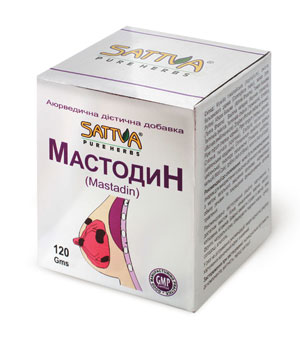Health Problems
Subscribe Newsletter
AYURVEDIC FORMULA IN THE TREATMENT OF MASTITIS
Mastadin
120 Gm
Mastitis - a benign fibrocystic growth of breast tissue. According to statistics, this disease occurs in 60 - 90% of women.
Mastitis remains the most common breast disease. It can develop to benign tumors of the breast: fibroadenoma, ductal papillomatosis. Besides, three to five-times increases the risk of developing breast cancer. The primary cause for development of disease is disturbance of the balance of hormones in the body. Mastitis occurs predominantly in women of reproductive age, in rare cases, men are exposed to the disease.
Types of Mastitis
Abnormal growth of connective tissue leads to the appearance of nodules and cords. These phenomena are characteristic of the diffuse mastitis. Later, the formation of solid nodules is observed and then formation of nodular mastitis. Besides, diffuse form of mastitis is distinguish from prevalence of cystic or fibrous components. There are mixed diffuse disease of the breast and sclerosing adenosis.
How mastitis is manifested
- Pain in the breasts - persistent or associated with the menstrual cycle.
- The appearance of nodules in the breast - multiple and small size (diffuse form), or a single and distinct (nodular form).
Causes of mastitis have not been studied sufficiently. There are only factors which may contribute to its occurrence. First of all, it is an imbalance of sex hormones, snozhenie or increased levels of thyroid hormones. Typically, such disorders occur when:
- Diseases of the ovaries (mostly adnexitis - inflammation of the ovaries).
- Diseases of the thyroid gland.
- Liver disease (impaired utilization of sex hormones).
- A variety of endocrine disorders.
Causes of Mastitis
The first of the provoking factors may include abortion. It is a roughest interference in harmonious hormonal system of the female body, adjusted for pregnancy. The mammary gland starts preparing for milk production from the very first days of pregnancy and by the time of abortion, significant changes already occurs in her. Forced rotation of the process in the opposite direction, of course, very harmful effect on breast tissue. The violent turn of this process in the opposite direction, certainly makes very bad affect on breast tissues.
The second factor - gynecological diseases. The mammary gland is a single system with other organs of procreation, so any failure of the system strikes and breast. This is why 75% of gynecological inflammatory diseases are accompanied by changes in the mammary gland. Sometimes, to provoke the development of mastitis enough even a simple "stagnation" in the sexual sphere.
Breast tissues refers to hormonal organs, i.e. the state of its glandular tissue changes depending on the phase of the menstrual cycle. Provoke mastitis can be the diseases of other organs, not related to the genital system. The mammary gland is part of the endocrine system of the body along with the ovaries, liver, thyroid and pancreas, adrenal glands. Therefore, any disease of these organs may lead to changes in it.
Besides, as cancers, mastitis is largely - the result of neurological disorders. Frequent stress, not passing a nervous tension, anxiety about the future – often usual state. Emerging from nervous disorders, breast disease itself becomes a cause of severe stress, anxiety, depression women. The emergence of pain in the breast, seals, discharge from the nipple are the reason for referral to a specialist, Mammologist. Timely detection and treatment of mastitis and other changes in the mammary glands, is a reliable prevention of cancer of the body.
Since ancient times to treat mastitis ayurvedic herbal formulation are used, which included plants and minerals, that normalize hormones and promotes the resorption of fibro-cystic formations. These are ayurvedic plants like Shatavari, Ashoka, Guggul, guduchi, Ginger and Turmeric and Shilajit. These and other plants and minerals are part of the Ayurvedic formula Sattva Mastadin.
Benefits
- Creates a balance of sex hormones.
- Reduces pain in the chest.
- Eliminates the inflammation of the lymph nodes.
- Regulates monthly cycles.
- Promotes blood circulation in the reproductive organs.
- Eliminates the fibro-cystic formation.
- Protects against anemia.
Main ingredients of Sattva Mastadin:
Shatavari (Asparagus racemosus) - Shatavari is translated from Sanskrit as "having a hundred men." Shatavari is a great anti-aging plant for female reproductive system. Shatavari normalizes the monthly cycle, prevents the development of fibroids and mastitis, increases the ability to fertilize egg cells, increases the production of breast milk. The plant is rich in bioflavonoids and natural antibiotics, containing analogues of female sex hormones.
Ashoka (Saraca indica) - a sacred tree in India. Ashoka is a symbol of love and guardian of virginity. In Ayurvedic medicine is used to treat various diseases of the female reproductive system, menstrual disorders. It has anti-inflammatory and astringent.
Guggul (Commiphora mukul) - thorny shrub with white or yellow flowers and unusual fruits on the form. If the fetus is damaged milkweed - myrrh, which contains gum, resin, essential oils. Guggul has a very strong purifying and rejuvenating effects. In Ayurvedic medicine, preparing a wide range of herbal remedies based on guggul.
Kanchnar (Bauhinia variegata) - Orchid Tree. Striking with its beauty during flowering. Bauhinia flowers colorful flowers like orchids. Kanchnar - one of the most famous Ayurvedic plants used in the treatment of neoplastic diseases of the female reproductive system. It promotes the resorption of cysts.
Guduchi (Tinospora cardifolia) - very large perennial vine. Traditionally used to strengthen the immune system.
Nirgundi (Vitex negundo) - tree-like shrub. Its berries contain diterpenes, contributing the balance of sex hormones in the female body. Vitex increases the function of sexual glands. It is used in the treatment of mastitis, uterine fibroids, menstrual disorders, infertility.
Sunthi (Zingiber officinale) - one of the oldest spice plants. Medicinal raw materials are rhizomes, that contain essential oils. It has antioxidant, anti-inflammatory, antispasmodic effect. It improves overall body tone and enhances sexuality.
Haridra (Curcuma longa) - This spicy-aromatic herbaceous plant of the ginger family. Homeland turmeric - South-East India. Turmeric has a remarkable curative effect on the human body. turmeric root powder is used in Ayurvedic medicine for medicinal purposes since ancient times. It contains phosphorus, iron, iodine, calcium, vitamin C, K and B vitamins, essential oil. The strongest antioxidant. It contains yellow pigment - curcumin. Recently, Indian scientists established the immunomodulatory properties of curcumin.
Turmeric - a wonderful natural antibiotic, while improving digestion and contributes to the normalization of intestinal microflora.
Turmeric improves blood circulation, promotes the formation of red blood cells and platelets decreases, regulates metabolism, stimulates the immune system.
Turmeric helps in for the regulation of menstruation. It is also used in the treatment of premenstrual syndrome and leukorrhea (white descharge). It has a positive effect on tumors of the breast in women.
Shilajit (Asphaltum) - Natural "magic balm" with amazing properties. This is the most unusual and mysterious remedy, which since ancient times argue and say, healers and doctors. Shilajit is a complex chemical structure formation, mined in some mountain areas of the world. Ancient treatises contains a lot of material on the use of Shilajit, as a means of enhancing the regenerative processes in different tissues of the body, anti-inflammatory, antitoxic and tonic preparations.
Shilajit contains about 28 chemical elements, 30 macro- and microelements, 10 metal oxides, 6 amino acids, a number of vitamins, essential oils, and more. Spectrum of action of shilajit is very wide. It is used to strengthen the immune system and the treatment of various diseases, improves the general condition of the body.
Loh Bhasma –Iron oxide (Ash of Iron) - included in the hemoglobin of red blood cells, muscle tissue, bone marrow, liver and spleen. It promotes effective delivery of oxygen to the tissues for cellular respiration. It helps with anemia.
Rajat Bhasma - Silver oxide (Ash of Silver) - a powerful anti-inflammatory agent. It has an antibacterial effect, suppresses pathogenic microflora.
Suvarna Bhasma - Gold oxide (Ash of Gold) - is used in Ayurveda as a fortifying agent for the treatment of tumor diseases. Included in the drugs, reducing the reproductive system and increase vitality.
Diet and lifestyle:
Diet: eliminate meat and fried food, sweets and alcohol. Eat more plant foods - whole grains, such as wheat, oats, millet and brown rice. Products with essential fatty acids which provide the body with calcium. Seasonal fresh vegetables and fruits: pomegranate, coconut, watermelon, peaches, raisins. Reduce the use of products containing animal proteins, as it increases estrogen levels. Alcohol, caffeine, spicy foods and smoking break down minerals and vitamins of group B. Keep an active lifestyle. Well perform daily exercise.
Ingredients
Shatavari (Asparagus racemosus), Ashoka (Saraca indica), Haridra (Curcuma longa), Nirgundi (Vitex negundo), Sunthi (Zingiber officinale), Guduchi (Tinospora cardifolia), Kanchnar (Bauhinia variegata), Shilajit (Asphaltum), Guggul (Commiphora mukul), Loh Bhasma (Ash of Iron), Rajat Bhasma (Ash of Silver), Suvarna Bhasma (Ash of Gold).
Dosage
1 teaspoon (2 gm) two times a day 15-20 minutes after meal. Take with a solution of Sattva Suraktam syrup - 15 ml to 50 ml of water.
Indications
mastitis, nodal breast, fibrocystic breast disease, fibrosing adenosis, sclerosing adenosis.
Contradiction
individual intolerance to the components of the preparation, pregnancy and breastfeeding.
Packing
120 grams ± 2% powder in food grade acrylic- metal container.
Storage
Store in a cool dry place, protected from moisture and light, at a temperature no higher than 30 C.

